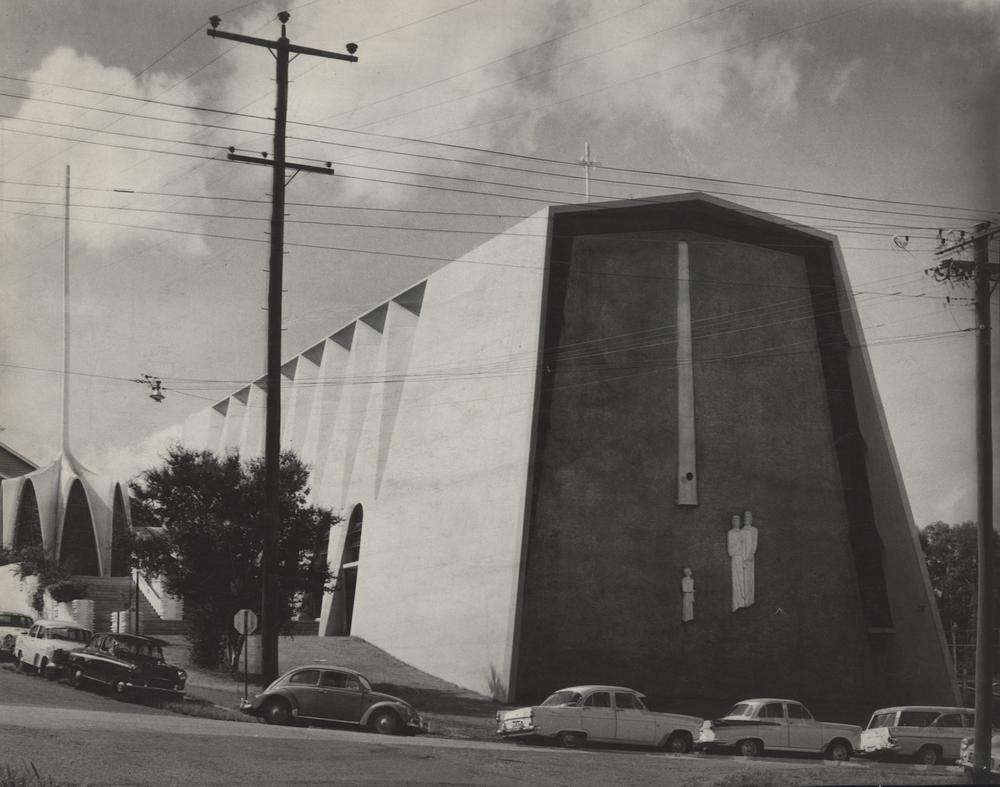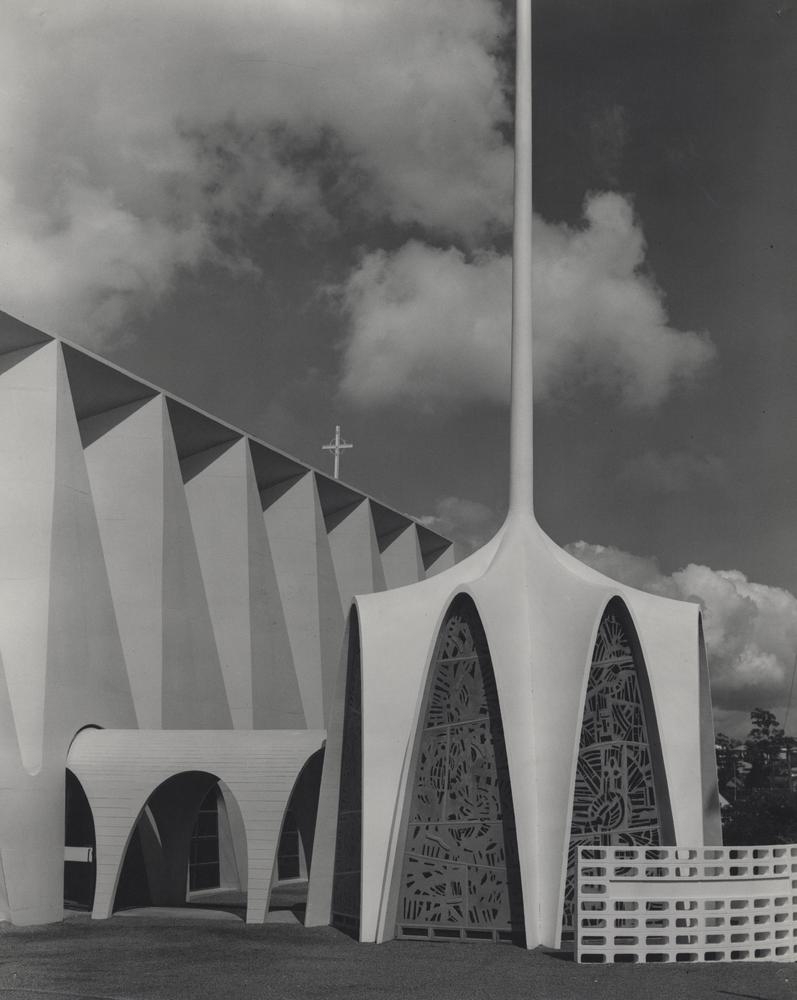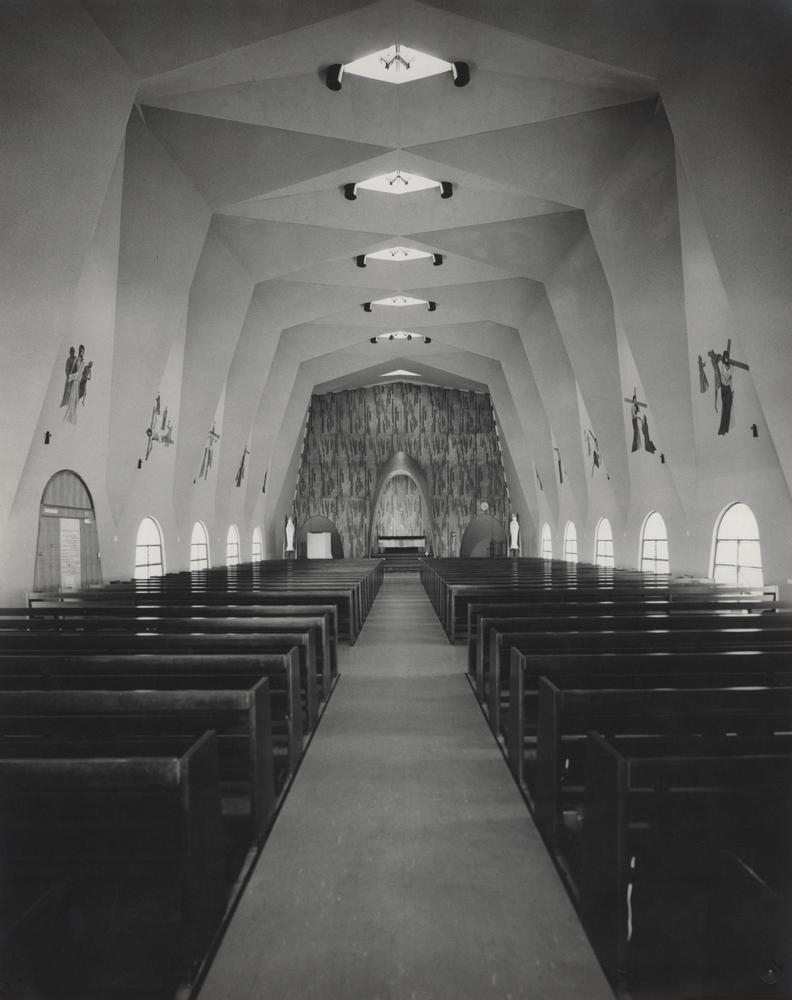Addresses
Type of place
Church
Period
Late 20th Century 1960-1999
Style
Ecclesiastical
Addresses
Type of place
Church
Period
Late 20th Century 1960-1999
Style
Ecclesiastical
The Church of the Holy Family was built in 1961-63 and designed by Brisbane architectural firm, Douglas and Barnes. Built beside the original timber interwar church it demonstrates the ongoing spiritual needs of the Indooroopilly Catholic community. The church’s striking design is a rare example of Modernist architecture in Brisbane. The church was built under the direction of Archbishop James Duhig and was one of his last major building projects. The church contains several elements that contribute to the cultural heritage significance of the building: the Stations of the Cross painted by Ray Crooke; the external sculptures designed by Erwin. A. Guth; the baptistery mosaic windows designed by Andrew Sibley.
Lot plan
Key dates
Local Heritage Place Since —
Date of Citation —
Construction
Walls: MasonryPeople/associations
Douglas and Barnes (Architect)Criterion for listing
(B) Rarity; (D) Representative; (E) Aesthetic; (F) Technical; (G) Social; (H) Historical associationInteractive mapping
Lot plan
Key dates
Local Heritage Place Since —
Date of Citation —
Construction
Walls: MasonryPeople/associations
Douglas and Barnes (Architect)Criterion for listing
(B) Rarity; (D) Representative; (E) Aesthetic; (F) Technical; (G) Social; (H) Historical associationInteractive mapping
History
Prior to the establishment of a Catholic parish and church in the Indooroopilly district the area came under the larger parish of Toowong. The closest church at this time for the Indooroopilly district was St Michaels in Toowong. Alternatively, Mass was often held in peoples’ homes or in the Stamford Hall (now demolished), that was situated beside what is now known as the Indooroopilly Hotel. By the 1920s it was apparent that a separate parish was needed for the Indooroopilly district. The Catholic community in the area made an urgent request to the Archbishop for a parish to be established for Indooroopilly. This request was acted upon.
In early 1926 Archbishop James Duhig purchased a large portion of land at Indooroopilly. The land had been in the ownership of Gilson Fox Leslie Foxton, eminent Indooroopilly resident. It was Duhig’s intension to establish a church and school on the site. Present on the property was the nineteenth-century brick residence ‘Warranoke’. The period in which the property was purchased saw an unprecedented amount of property acquisition and building by the Catholic Church in Brisbane. In July 1926 the first Church of the Holy Family was officially opened. The timber building, designed by Brisbane architects Hall and Prentice, was initially used as both the church and the primary school. The school was run by the Brigidine Sisters who came to Brisbane in 1927 on invitation from Archbishop James Duhig. In the preceding years the Indooroopilly congregation grew, so too did enrolment numbers at the primary school.
In the early 1960s a new church was proposed for the Indooroopilly parish. The old church was to be converted entirely into classrooms. The design for the new church was created by Brisbane architectural firm, Douglas and Barnes. The foundation stone was blessed and laid by Archbishop Duhig in 12 November 1961. The progressive design was an important example of Modernist architecture, rarely seen in Brisbane. In an article entitled “Striking Church at Indooroopilly” in The Catholic Leader August 1961, it was stated that:
His Grace Archbishop Duhig is shown a model of the proposed new Church of the Holy Family at Indooroopilly, by the architect, Mr. William Douglas (of Douglas and Barnes Architects, Brisbane). The church has been designed along simple, striking lines and will be constructed of concrete, with sections in walls and ceiling. It will cost approximately £70, 000 and will seat 615 people.
Douglas and Barnes were a respected architectural firm in Brisbane and the Gold Coast. Established in 1955 the partnership, made up of William. L. Douglas and Barry Barnes, designed many houses, apartments and commercial premises both in Brisbane and the Gold Coast until 1972.
Importantly, the new Church of the Holy Family was designed and built prior to the implementation of Vatican II, ensuring that the design of the church followed the traditional layout of a Catholic church. The church also follows the traditional siting of a Christian church in an east-west axis.
The progressive design of the church meant that the way in which it was built was unusual, both from an architectural point of view and an engineering one. The Catholic Leader addressed this in November 1963:
The church is built of reinforced concrete walls on a 10 degree angle, with concrete roof and detached octagonal baptistery with concrete glass window walls. The architects of the church…discarded all previous concepts of church design and were influenced entirely by their findings and their own interpretations of them. All slickness was eliminated, types of finishes kept to a minimum, and the whole designed for a feeling of solidity and strength of character.1
The construction method used to build the Church of the Holy Family was, at the time, technologically advanced. By using a new method of concrete construction it created a pleated concrete structure. The Catholic Leader outlined the advanced methods that were used in construction:
The main structure, “growing’ out of the sloping site and towering over the surrounding area, is cast ‘in situ’ off form, concrete. The method of construction was most unusual. The foundations, ground floor and main first floor were poured in the normal manner. However, the upper portion of the building was constructed from end to end by means of a mobile steel framed collapsible Jumbo. Instead of the building growing upwards, it grew longitudinally.”1
Several art pieces were commissioned by the Catholic Church to be incorporated into the design of the Indooroopilly church: the Stations of the Cross, external sculptures and baptistery windows.
Respected Queensland artist Ray Crooke was commissioned to paint the Stations of the Cross on the internal walls. An award winning Queensland artist throughout the 1960s to date, Crooke has won prestigious awards such as the Archibald Prize in 1969, an Order of Australia for services to the visual arts in 1993 and an Honorary Doctorate from Griffith University in 1996. Throughout the 1960s to date Crooke has had a succession of successful exhibitions throughout Australia and internationally and has several works in major art collections including state galleries, the National Gallery of Australia and the Vatican Collection in Rome.
In a move away from traditional Roman Catholic depictions of the Stations of the Cross, those designed for the Church of the Holy Family were to be painted directly onto the walls as frescoes. The Stations of the Cross are a Roman Catholic tradition dating back to the late medieval period in Europe that depict the final hours of Jesus’ life. There are fourteen Stations: Jesus in the Garden of Gethsemane; Jesus is betrayed by Judas and arrested; Jesus is condemned by Sanhedrin; Jesus is denied by Peter; Jesus is judged by Pilate; Jesus is scourged and crowned with thorns; Jesus takes up His cross; Jesus is helped by Simon to carry His cross; Jesus meets the women of Jerusalem; Jesus is crucified; Jesus promises His kingdom to the repentant thief; Jesus entrusts Mary and John to each other; Jesus dies on the cross; Jesus is laid in the tomb. The series of Stations have been depicted on the internal north and south walls inside the church.
On the exterior of the church there are two separate sets of sculptures. The largest of these is entitled “Finding of the Child Jesus in the Temple”, and is situated on the western end of the church. The other, smaller set that depicts the Holy Family, is located on the northern side close to the entry of the church. The commission for the sculptures was given to Brisbane artist Erwin. A. Guth. Before migrating to Australia in the early 1950s the German born artist had studied at the Berlin Academy of Fine Arts and became the teacher of sculpture at the Ministry of Public Worship and Instruction in the German district known as Saar. Throughout his career as an artist Guth had designed several sculptures for both secular and ecclesiastic theatres, for example the “Dolphins” sculpture at Redcliffe, the Crucifix at St. Andrew’s Anglican Church at Indooroopilly, and a the sculpture of St. James in St. James’ Cathedral in Townsville.
Another important feature of the Church of the Holy Family is the baptistery, situated on the northern side of the church beside the entrance, with a covered walkway from the baptistery to the church. The design of the baptistery mosaic windows is attributed to respected Queensland artist, Andrew Sibley; the windows represent the Seven Sacraments. The English born artist migrated to Australia after the Second World War. Throughout the 1960s to date Sibley has won many awards for his art. The baptistery was designed as a precast concrete octagonal structure with a high concrete spire and coloured glass on the walls of the baptistery to resemble stained glass.
The suspended organ within the church is important as the only suspended organ in Brisbane.
The new church was officially blessed and opened by Archbishop Duhig on Sunday 10 November 1963. The Church of the Holy Family is a striking and rare example of Modernist architecture in Brisbane.
Description
The church and baptistery are landmarks in the local area with their prominent setting on a hillside corner site. Beside the imposing presence of the church, a set of wide, processional stairs lead up to the baptistery and church forecourt at the top of the hill. The forecourt contains a curved breezeblock wall.
The church is designed in the Modernist style and is composed of a trapezoid form with folded wall and ceiling planes. Chevron shaped motifs are used both internally and externally and windows consist of multi-paned trapezoids topped with round arches.
The church has a traditional rectangular plan form; the main level consists of the entrance vestibule, nave and sanctuary, with the sacristy behind; the lower level contains a basement and store; the upper level includes a gallery, accessed via a spiral staircase, which overlooks the nave.
Materials include a combination of off-form concrete and pre-cast concrete panels. External wall finishes consist of rough, cement stucco finish to the west end wall; a series of pre-cast concrete channels to the east end wall; the north and south walls feature rough, shotcrete panels which contrast with areas of smooth faced concrete.
Internally, the ceiling of nave features chevron-shaped panels of T&G off-form concrete with the remainder of the ceiling finished with acoustic plaster. The nave is naturally lit from above by diamond shaped skylights set into the folded roof plane. The church interior contains several original architectural features including the decorative steel screen in the Sanctuary and the metal domed altar structure. A pipe organ is suspended on steel cables above the gallery and the cylindrical light fittings appear to be original. Original artworks inside the church include the Stations of the Cross frescoes which continue down each side of the nave above the windows.
The baptistery is a separate structure, accessed via a covered walkway from the church nave or courtyard, and is constructed of pre-cast concrete shells poured in-situ. Its round plan form is enclosed by a series of parabolic arches with a tall central spire which reaches higher than the adjoining church. Each arched opening contains a specially commissioned mosaic stained glass window, with the glass set directly into the concrete.
Statement of significance
Relevant assessment criteria
This is a place of local heritage significance and meets one or more of the local heritage criteria under the Heritage planning scheme policy of the Brisbane City Plan 2014. It is significant because:
Supporting images
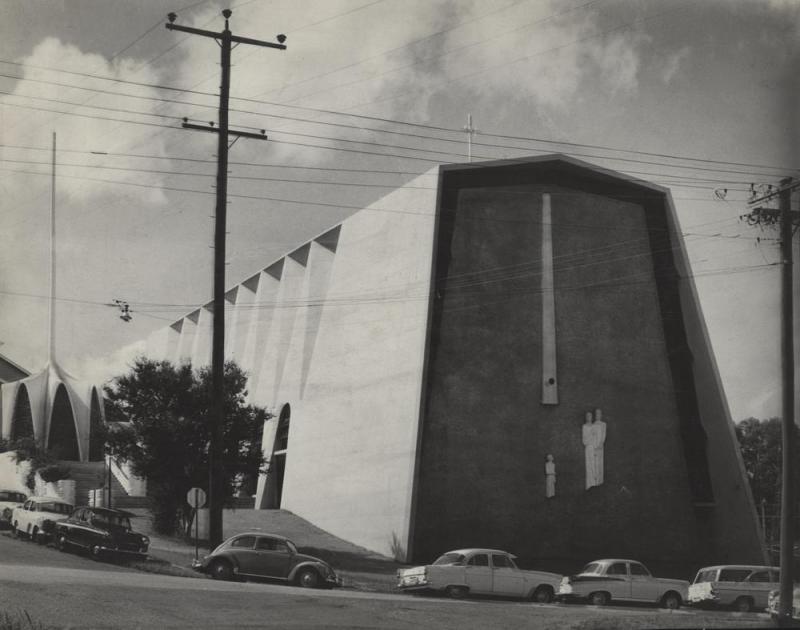
L. & D. Keen Pty. Ltd. (photographers) for the Royal Australian Institute of Architects (Queensland Chapter),
'Holy Family Catholic Church at Indooroopilly, Queensland', c.1963,
John Oxley Library, State Library of Queensland

L. & D. Keen Pty. Ltd. (photographers) for the Royal Australian Institute of Architects (Queensland Chapter),
‘Holy Family Catholic Church in Indooroopilly, Queensland’, c.1963,
John Oxley Library, State Library of Queensland

L. & D. Keen Pty. Ltd. (photographers) for the Royal Australian Institute of Architects (Queensland Chapter),
‘Archway at the Holy Family Catholic Church in Indooroopilly Queensland’, c.1963,
John Oxley Library, State Library of Queensland
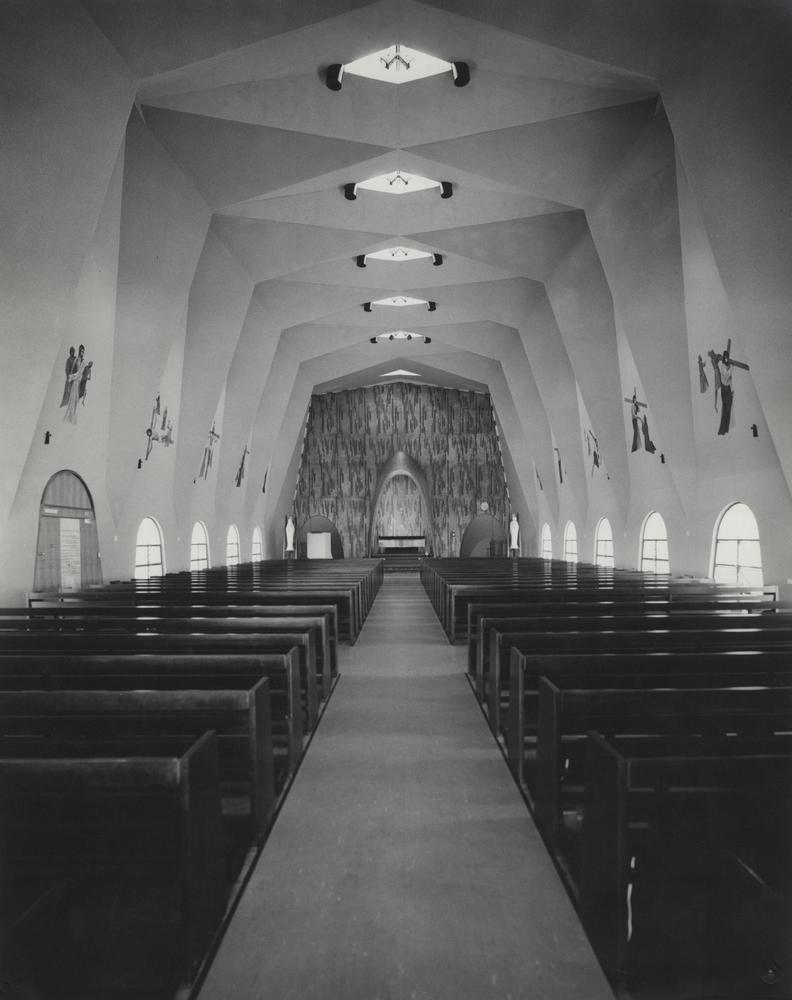
L. & D. Keen Pty. Ltd. (photographers) for the Royal Australian Institute of Architects (Queensland Chapter),
‘Interior of the Holy Family Catholic Church at Indooroopilly Queensland’, c.1963,
John Oxley Library, State Library of Queensland
References
-
The Catholic Leader, November 1963
-
The Catholic Leader, November 1963
-
Celebrating 75 Years, 1929-2004 Brigidine College Indooroopilly, Anniversary Booklet
-
Donald Watson and Judith McKay, Queensland Architects of the Nineteenth Century, South Brisbane: Queensland Museum, 1994
-
Historic Titles, Department of Environment and Resource Management
-
Queensland Post Office Directories
-
Metropolitan Water and Sewerage Survey Maps
-
MacGinley, Rosa, “Irish Women Religious and their Convent High Schools in Nineteenth Century Australia”, Australian Journal of Irish Studies, V.5, p.135-149
-
“Residence, 8 Westminster Street (1890s) 602057” Department of Environment and Resource Management Queensland Heritage Citation
-
Queensland Heritage Citations
-
Queensland Electoral Roll
-
The Catholic Leader, 23 June 1955, p9
-
Diamond Jubilee: Holy Family Parish, Indooroopilly, 1926-1985, Ed Erin Ahearn, 1986
-
Douglas and Barnes, Plans of Church of the Holy Family
-
Bolan, T., James Duhig, University of Qld Press, 1986
-
The Catholic Leader, November 1964
-
The Brisbane Courier, 19 May 1917, p15
-
The Brisbane Courier, 2 November 1895, p861
-
The Brisbane Courier, 10 March 1891, p 6
-
The Brisbane Courier, 26 March 1926, p8
-
The Catholic Leader, November 1961
-
The Catholic Leader, August 1961
-
The Brisbane Courier, 2 January 1928, p12
-
The Brisbane Courier, 5 July 1926, p8
-
Brisbane City Council Building Cards
-
14 January 1927, ‘Letter to Archbishop Duhig from Randwick Brigidine Convent”, Brisbane Archdiocese Archive
-
Brisbane City Council, Register of New Buildings
-
Tenders, March 10 1926, The Architect and Builders’ Journal of Queensland
Citation prepared by — Brisbane City Council (page revised September 2020)
